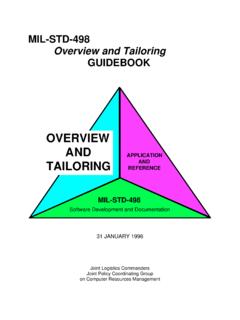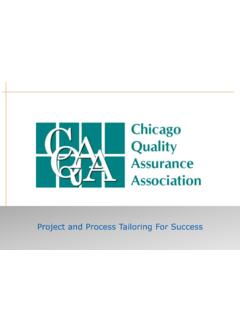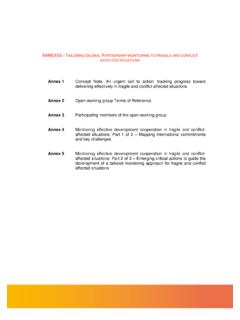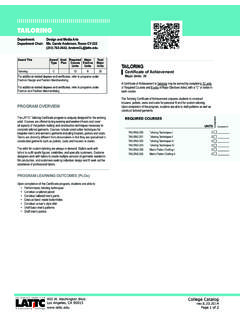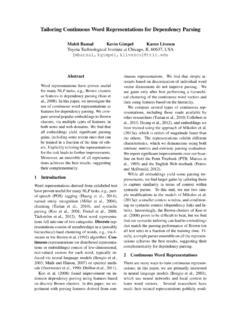Transcription of Topic 7: Tailoring the Conversation - Nevada WIC
1 Topic 7: Tailoring the Conversation Always remember that you are absolutely unique. Just like everyone else. - Margaret Mead 1 Nevada WIC Contents: Key messages for Champions .. 2 Activities for staff .. 5 Ideas for facilitated conversations with staff .. 9 Sample script .. 10 Observation guide .. 14 Self observation guide .. 15 Handouts .. 16 References/Resources .. 18 2 Nevada WIC Key Messages for Champions Within the Nevada model, WIC staff members address the individual needs and interests of each participant. Every Conversation is therefore unique and tailored to that person. Because individuals vary in the way they learn and process information, WIC staff members must be flexible, matching their style to the participant s needs.
2 The skills are designed to foster a two-way interactive discussion that will help to tailor the WIC session. This section will explore the process of Tailoring the Conversation to maximize the effectiveness of every WIC encounter. Tailoring the Conversation WIC participants may be different ages, represent different cultures, speak different languages and have different histories and life experiences. They can also vary in: Readiness to adopt healthy nutrition-related behaviors Levels of education and nutrition knowledge Attitudes and beliefs about nutrition and health Desire or need for information Communication and education techniques that are effective with one individual may not fit the needs of another. Nutrition education and counseling skills should be tailored to align with the needs of the individual in order to maximize the impact the WIC experience.
3 By using the skills, such as open-ended questions and reflective listening, WIC staff can learn more about what motivates each participant and what strategies will empower them to make positive changes in their lives. Tailoring to the stage of change WIC participants vary greatly in their readiness to change their health and nutrition-related behaviors. A participant s readiness to change is identified during the WIC nutrition assessment process. Identifying their readiness to change can help you decide how to approach the Conversation . For example, participants that display strong signs of readiness to change may be more likely to benefit from concrete goal setting strategies. Signs of readiness to change include: Making statements about wanting to change, or citing reasons for the need for change.
4 Asking questions about change such as what they could do about a problem or how other people have addressed the issue. Talking about how life might be different after the change. Experimenting with possible changes. Mirroring Mirroring a participant s language style, body language, or tone of voice will often help to build rapport and improve communication. Studies show that mirroring helps the participant subconsciously feel as if you are like them, which helps to build comfort, trust and openness. Some participant characteristics that can be mirrored include: 3 Nevada WIC Tone of voice. Example: If the participant is soft spoken, it may help if you use a soft tone as well. Body language. Example: If a participant is relaxed, and is sitting back in their chair, they may feel more comfortable if you adopt a relaxed demeanor as well.
5 Language style. Example: Often teenagers may use slang or more casual terms. Using the same words they use may help to build rapport. Note: In some situations it is best not to mirror the participant s affect. If the participant is angry and upset, adopting an angry demeanor will often cause the participant to continue to be upset. In this situation, maintaining a calm and relaxed manner may motivate the participant to mirror you and become less agitated. Cultural differences WIC staff members serve participants from multiple cultures and ethnic backgrounds. They may have different knowledge, attitudes, and beliefs. Learning about various cultural customs and values helps us to understand possible issues that may be important to our participants. Although some practices and beliefs may be common in particular cultures, it is important to remember that there is great diversity within each cultural group.
6 One way to avoid assumptions is to ask participants about cultural influences, foods and traditions to allow them to share their own unique story which impacts the way they think and their belief systems around food and health. Tailoring for age WIC participants represent all age groups, from the pregnant teenager to the grandparent caregiver. How and what you communicate may differ depending on someone s age. Adolescence, for example, is a turbulent time. Teenagers are often in different stages of development. Teen mothers exhibit higher rates of depression, stress, and lower rates of self-esteem than other mothers. They are often seeking independence from parents, yet are influenced greatly by the beliefs and behaviors of their peers. As with all participants, conversations with teens should be tailored to their lifestyles and be realistic for their situation.
7 For example, if a teen s goal is to eat better for her baby, helping brainstorm ideas of healthy choices at fast food restaurants may be more helpful than telling her to avoid fast food and prepare her meals at home. Helping the teen to believe in herself and her abilities will build her self-esteem. What motivates teens to adopt healthy behaviors may be different than what motivates the older adult. With teens and with participants of any age, using the skills will help tailor the WIC session to the motivations and goals that are unique to them. Dealing with difficult people At WIC, staff members must occasionally deal with participants that can be labeled as difficult. Difficult participants may display characteristics as being angry, argumentative, or uninterested in the information shared.
8 Participants have different life experiences and may have different reasons for 4 Nevada WIC their reactions. Sometimes, resistance in the WIC participant may be aggravated by the style of the WIC staff. Resistance may be a sign that the participant feels they are being pushed to make a change when they are not ready. They may feel they have little control, or are being told what to do, or what they are doing is wrong. Signs of resistance can include arguing, blaming, interrupting, making excuses, or inattentiveness. WIC staff members can use skills that will reduce resistance in the WIC participant. A few of the skills to deal with resistant participants include: Acknowledging the resistance: o Example: You re frustrated because it seems like when you come to WIC, what you need to bring changes.
9 Sometimes we ask you to bring your son and sometimes we don t. Reflecting the resistance: o Example: Quitting smoking right now is not something that is going to work for you. Change the focus of the Conversation : o Example: For you his weight is not a concern and you say the doctor has not mentioned that it is an issue. Perhaps today, we can talk about some of the things you do to encourage him to eat healthy things. Emphasize personal control: o Example: It is completely up to you. Some mothers have found that stopping the bottle all together is the best strategy, where other mothers have found weaning gradually is the best way. What would work best for you, do you think. Empathize with their feelings: o Example: It must be frustrating to have to rearrange your whole schedule to find a time to come to WIC.
10 Apologize: o Example: I am sorry that it was unclear about what you needed to bring for this visit. Would it help if I explained which information we will need each time that you recertify and why we need it. Personalizing the exchange Some simple strategies will help to personalize the Conversation , helping to build rapport between WIC staff and WIC participants. Two techniques for personalizing the session include: Using the participant s name. This is a simple and powerful strategy to get their attention and highlight what you are about to say. It will often help to personalize the exchange and enhance the helping relationship. Asking questions about participant s culture, home life and traditions. Showing interest in another person s life is a way to establish trust. Being an attentive listener and showing interest will make the participant more likely to trust and open-up.
